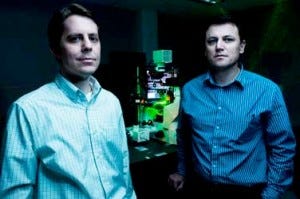Scientists Deploy Lasers and Nanoparticles to Pop Cancer Cells
February 12, 2010

nanobubble-laser-cancer-tech
By using lasers and nanoparticles, Jason Hafner and Dmitri Lapotko have discovered how to single out individual diseased cells and destroy them with tiny explosions.
Using lasers and nanoparticles, scientists at Rice University (Houston) have discovered a new technique for singling out individual diseased cells and destroying them with tiny explosions. As presented in the journal Nanotechnology, the method uses lasers to make "nanobubbles" by zapping gold nanoparticles inside cells. In tests on cancer cells, they found that they could tune the lasers to create either small, bright bubbles that were visible but harmless or large bubbles that burst the cells."Single-cell targeting is one of the most touted advantages of nanomedicine, and our approach delivers on that promise with a localized effect inside an individual cell," remarks physicist Dmitri Lapotko, the lead researcher on the project. "The idea is to spot and treat unhealthy cells early, before a disease progresses to the point of making people extremely ill."Nanobubbles are created when gold nanoparticles are struck by short laser pulses. The short-lived bubbles are very bright and can be made smaller or larger by varying the power of the laser. Because they are visible under a microscope, nanobubbles can be used to either diagnose sick cells or to track the explosions that are destroying them.In laboratory studies published last year, Lapotko and colleagues at the Laboratory for Laser Cytotechnologies at the A.V. Lykov Heat and Mass Transfer Institute in Minsk, Belarus, applied nanobubbles to arterial plaque. They found that they could blast right through the deposits that block arteries. "The bubbles work like a jackhammer," Lapotko said.In the video below from that study, rapidly expanding nanobubbles blasted through arterial plaque. Gold nanoparticles were sprayed on the plaque (from the left) and illuminated with a laser from above. With the backlighting turned off, each bubble shows up as a brilliant flash.In the current study, Lapotko and Rice colleague Jason Hafner, associate professor of physics and astronomy and of chemistry, tested the approach on leukemia cells and cells from head and neck cancers. They attached antibodies to the nanoparticles so they would target only the cancer cells, discovering that the technique was effective at locating and killing them. "The mechanical and optical properties of the bubbles offer unique advantages in localizing the biomedical applications to the individual cell level, or perhaps even to work within cells," explains Hafner.Resulting from collaboration between Rice University and the Lykov Institute of the Academy of Science of Belarus, the nanobubble technology could be used for theranostics, a single process that combines diagnosis and therapy. In addition, because the cell-bursting nanobubbles also show up on microscopes in real time, the technique could be used for posttherapeutic assessment, according to Lapotko.For additional Medtech Pulse posts on the use of nanotechnology for treating disease, see "Scientists Enlist Nanoburrs to Unclog Arteries," "Scientists Examine How Nanoparticles Interact with Blood," and "Nanoparticles Wage War on Cancer."
You May Also Like
.png?width=300&auto=webp&quality=80&disable=upscale)

